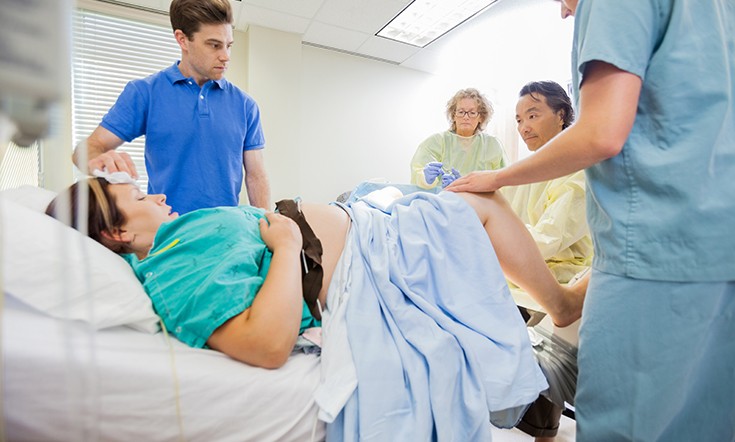

The second stage of labour is also known as the “pushing” stage and occurs after the cervix is completely dilated and the baby is completely out of the birth canal. Pushing is characterised by contractions that are generally occurring less frequently than in the end of first stage.
What Happens In The Second Stage Of Labour?
Cervix
Mum’s cervix is completely effaced, and dilated to 10 cm.
Position
During the second stage of labor, the baby completes a series of “cardinal movements.” Typically, a baby begins facing the mother’s side, so the largest dimension of his head (front to back) enters the widest dimension of her upper pelvis (side to side.) As the baby descends, he bows down to his chest (flexion) and rotates his head 90 degrees so that he is facing toward his mother’s back (anterior position).
During birth, this allows the largest dimension of his head to pass through the widest dimension of the pelvic outlet (front to back). After his head has passed through the vaginal opening, he again rotates so his shoulders will slip out easily.If the baby rotates to face the mother’s front instead of her back (occiput posterior), it may lead to back labour, as the back of his head presses against the mother’s sacrum.
Second Stage Of Labour Signs
There is increased blood show and a desire to bear down or have bowel movement. Dilatation of the anal sphincter and bulging of the perineum is also evident. In addition, you might also become irritable and complains of severe discomfort.
Station
In the second stage of labour, the baby descends into the pelvis. The measurement of this is “station.” When the baby is ‘floating’, the baby’s head is positioned slightly above the pelvic inlet. If in station -4 or -5, it means that the baby’s head is 4 or 5 cm above the mum’s ischial spines (the bony knobs at the bottom of your pelvis; sometimes you can feel these when sitting on a hard surface.)
The baby is defined as 0 station, or engaged, when his “presenting part” (usually his head) is even with the ischial spines. Many women are at 0 station when labour begins. At +2 or +3, his head is at the vaginal opening, and the perineum is bulging. Crowning, when the baby’s head is emerging, and it is considered +4 or +5 station.
How It Feels Like To Push?
Some women will feel what is called an urge to push. This is generally caused by the baby pressed onto the Ferguson Plexus of nerves, creating Ferguson’s reflex, the urge to push. You’ll feel the pressure of your baby’s head between your legs. With each contraction you may get two or three strong urges to push. Listen to your body and push when you get a strong urge. With every push, your baby will move through your pelvis a little.
Your health care provider will give you instructions when the baby’s head is visible and no longer slipping back between contractions. Your midwife may ask you to stop pushing and take perform your breathing techniques for the next two or three contractions. This is to ensure that your baby is born gently and slowly, and helps you avoid tearing or needing an episiotomy.
What Are The Positions For The Second Stage Of Labour?
There are several positions that you can use for pushing. It is important for your comfort to experiment with pushing in different positions. You can hasten the progress of the labour if you try positions where gravity assists you (i.e. sitting, or squatting). However, if the baby is delivering quickly, you may be able to slow the stretching of the perineum by trying positions where gravity is neutral (such as getting on your hands and knees or lying on your side).
Many women find pulling a towel or sheet held by a partner or tied on the squat bar to be very effective during a pushing contraction. In all positions, it is important for you to know that you should tuck your chin down and use a rounded back to help your abdominal muscles assist your uterus in pushing your baby.
Breathing Techniques
The breathing techniques used for the second stage of labour are varied and depend upon which works best for you. Your health care provider will give instructions and assistance. Deal with your contractions to maximise your efforts at the peak of the contraction. Groaning may also be helpful while pushing. Allow yourself the freedom to make the sounds that come naturally. It is unnatural and possibly damaging to you and your baby to hold your breath for a long time. Holding your breath while pushing is fine to do if you feel it assists with bearing down.






















